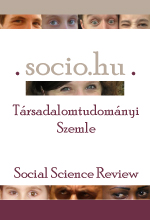Heteronormatív ifjúság?
Heteronormative youth?
X
Author(s): Anikó Gregor, Dorottya RédaiContributor(s): Judit Takács (Editor)
Subject(s): Social Sciences
Published by: MTA TK Szociológiai Intézet
Keywords: youth; homosexuality; attitudes; heteronormativity; family
Summary/Abstract: Earlier Hungarian studies analysing attitudes towards homosexuality and homosexual people almost uniformly claim that younger cohorts show more tolerant attitudes towards gay and lesbian people than older cohorts. In this study we examine, analysing data from the representative survey Hungarian Youth 2012, how heteronormative the notions of young people aged 15–29 about family as the cohabitation of a couple are, and what socio-demographic and attitudinal variables explain these notions. Our findings show that nearly half of the young people in the sample fully agree with the statement that “the cohabitation of a same-sex couple cannot be considered a family”, and only one in twelve fully disagrees. Heteronormative attitudes are less characteristic of girls, those living in towns, those having parents with university degrees, and those in a better financial situation. Those young people who are married or plan to get married have more heteronormative views regarding the family, and the same is true of those who believe in traditional gender roles regarding the sharing of household and childcare responsibilities in the family. Certain discursive frames of public debates about the issue of family are present in the heteronormative attitudes of those who share positive nationalist values and those who share chauvinist nationalist values. Young people of Roma origin, especially girls, have more heteronormative views about the family than those of non-Roma origin. Another interesting finding concerns the family notions of young people with different sexual orientations: the least heteronormative are those who are attracted to both sexes, whereas gay and lesbian respondents did not consider the cohabitation of a same-sex couple to be a family to a similar degree to heterosexual respondents. In our analysis we attempt to find out what may be the causes behind these findings.
Journal: Socio.hu Társadalomtudományi Szemle
- Issue Year: 5/2015
- Issue No: 1
- Page Range: 122-143
- Page Count: 22
- Language: Hungarian

